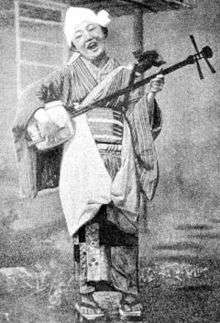Min'yō

Min'yō (民謡) is a genre of traditional Japanese music. The term is a translation of the German word "Volkslied" (folk song) and has only been in use since the twentieth century.[1][2] Japanese traditional designations referring to more or less the same genre include "inaka bushi" ("country song") "inaka buri" ("country tune"), "hina uta" ("rural song") and the like, but for most of the people who sang such songs they were simply "uta" (song).[3] The term min'yō is now sometimes also used to refer to traditional songs of other countries, though a preceding adjective is needed: Furansu min'yō = French folk song; for this reason, many sources in Japanese also feel the need to preface the term with "Nihon": Nihon min'yō = Japanese [traditional] folk song.
Many min'yō are connected to forms of work or to specific trades and were originally sung between work or for specific jobs. Other min'yō function simply as entertainment, as dance accompaniment, or as a components of religious rituals.[4]
Min'yō are also distinct depending on the area of Japan, with each area boasting its own favorite songs and styles. The songs found in the far northern island of Hokkaidō and sung by the Ainu people are usually excluded from the category of min'yō.[5] In the far south, (especially Okinawa) distinct genres of min'yō, differing in scale structure, language and textual forms, have developed as well.[6]
Most Japanese folk songs related to work were originally sung unaccompanied, either solo, or by groups (heterophonically). Some songs exhibit the same sort of "call and response" chant often seen in the Southern Black music of the United States. During the Edo period, however, and sometimes later as well, accompaniment on shamisen, shakuhachi and/or shinobue was added to min'yō melodies. Percussion instruments, especially drums, are also often featured in min'yō accompaniment, especially when such songs are used in dances or religious ceremonies. Some of these accompaniments, in turn, have become independent, spawning solo instrumental genres such as Tsugaru-jamisen.[7] Enka and many other popular genres are also rooted in min'yō.[8]
During the 20th century many songs have been altered to become highly virtuosic melodies that can only be negotiated with much time and effort.[9] Indeed, min'yō is now in effect a form of art music, often studied under professional teachers who may grant their leading students licenses and professional names.[10]
At the same time, in contrast to the "stage min'yō" of such professionals, many hundreds of "preservation societies" (hozonkai) have been established to help songs survive in their more traditional forms. Thus work songs may be sung unaccompanied, perhaps while imitating or enacting the original actions of the work. Most of these Preservation Societies "preserve" only one local song.[11]
There are also hundreds of min'yō contests, both national and local, again often for only one song.[12]
For many Japanese, min'yō evokes, or is said to evoke, a nostalgia for real or imagined home towns and family; hence the saying common among practitioners and fans of the genre: "Folk song is the heart's home town" / "Min'yō wa kokoro no furusato".[13]
Min'yō, traditional Japanese folk song, must be distinguished from what the Japanese call fōku songu, from the English phrase 'folk song'. These are Western-style songs, often guitar-accompanied and generally recently composed, of the type associated with Bob Dylan, Peter, Paul and Mary and the like, and popular in Japan since the 1960s. There is surprisingly little contact between these two worlds, min'yō and fōku songu.[14]
See also
References
- ↑ Hughes, David W. (2008). Traditional folk song in modern Japan: sources, sentiment and society. Folkestone, UK: Global Oriental Ltd. p. 9. ISBN 978-1-905246-65-6.
- ↑ Hughes, David W. (2008). "12: Folk music: from local to national to global". In A. Tokita & D. Hughes. The Ashgate Research Companion to Japanese Music. Farnham, UK: Ashgate. p. 446. ISBN 978-0-7546-5699-9.
- ↑ Hughes, David W. (2008). Traditional folk song in modern Japan: sources, sentiment and society. Folkestone, UK: Global Oriental Ltd. p. 9. ISBN 978-1-905246-65-6.
- ↑ Hughes, David W. (2008). Traditional folk song in modern Japan: sources, sentiment and society. Folkestone, UK: Global Oriental Ltd. pp. chapter 1. ISBN 978-1-905246-65-6.
- ↑ Chiba, Nobuhiko (2008). "14: The music of the Ainu". In A. Tokita & D. Hughes. The Ashgate Research Companion to Japanese Music. Farnham, UK: Ashgate. p. 446. ISBN 978-0-7546-5699-9.
- ↑ Thompson, Robin (2008). "13: The music of Ryukyu". In A. Tokita & D. Hughes. The Ashgate Research Companion to Japanese Music. Farnham, UK: Ashgate. p. 446. ISBN 978-0-7546-5699-9.
- ↑ Groemer, Gerald (1999). The spirit of Tsugaru: blind musicians, Tsugaru-jamisen, and the folk music of northern Japan, with the autobiography of Takahashi Chikuzan. Warren, Michigan: Harmonie Park Press. ISBN 9780899900858.
- ↑ Hughes, David W. (2008). Traditional folk song in modern Japan: sources, sentiment and society. Folkestone, UK: Global Oriental Ltd. pp. 42–45. ISBN 978-1-905246-65-6.
- ↑ Hughes, David W. (2008). Traditional folk song in modern Japan: sources, sentiment and society. Folkestone, UK: Global Oriental Ltd. pp. passim. ISBN 978-1-905246-65-6.
- ↑ Hughes, David W. (2008). Traditional folk song in modern Japan: sources, sentiment and society. Folkestone, UK: Global Oriental Ltd. pp. chapters 3, 4. ISBN 978-1-905246-65-6.
- ↑ Hughes, David W. (2008). Traditional folk song in modern Japan: sources, sentiment and society. Folkestone, UK: Global Oriental Ltd. pp. 212ff. ISBN 978-1-905246-65-6.
- ↑ Hughes, David W. (2008). Traditional folk song in modern Japan: sources, sentiment and society. Folkestone, UK: Global Oriental Ltd. pp. 201ff., 224ff. ISBN 978-1-905246-65-6.
- ↑ Hughes, David W. (2008). Traditional folk song in modern Japan: sources, sentiment and society. Folkestone, UK: Global Oriental Ltd. pp. 1ff. ISBN 978-1-905246-65-6.
- ↑ Hughes, David W. (2008). Traditional folk song in modern Japan: sources, sentiment and society. Folkestone, UK: Global Oriental Ltd. pp. 39–42. ISBN 978-1-905246-65-6.